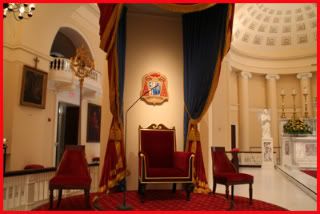 "Is Bishop McGrath feeling okay?" "Why doesn't he stand up to do his homily?" "Maybe he's just tired."
"Is Bishop McGrath feeling okay?" "Why doesn't he stand up to do his homily?" "Maybe he's just tired." I hear those comments often after a big diocesan liturgy like the Chrism Mass. Here and at other more solemn liturgies, the Bishop will usually give his homily sitting down. But don't worry. He's not tired, and he's doing just fine.
The reason a Bishop preaches while seated is because of the chair. It's not because it's a particularly comfy chair (some Bishops' chairs look downright hard and uncomfortable!). The chair of a Bishop at his cathedral is a special symbol of the Bishop. This chair, the "cathedra," is what gives the cathedral its name. A cathedral is the place where the cathedra is permanently located.
Cathedra means "chair" in Latin and "seat" in Greek (kathedra). You can spot the cathedra because it usually has the coat of arms of the diocese and the Bishop near it. Only the Bishop is allowed to sit in the cathedra because this chair is the sign of the Bishop's office and the unity among all the parishes in the diocese. If the Bishop is not present and another priest presides at Mass in the cathedral, he must sit in a different chair.
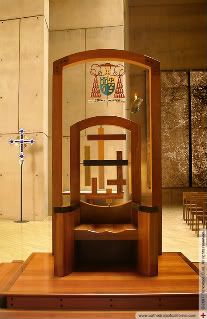 From the cathedra (or in Latin, "ex cathedra"), the Bishop exercises the three primary responsibilities of his office: "The office of Bishop as teacher, sanctifier, and pastor of his Church shines forth most clearly in a liturgy that he celebrates with his people" (Ceremonial of Bishops, 11).
From the cathedra (or in Latin, "ex cathedra"), the Bishop exercises the three primary responsibilities of his office: "The office of Bishop as teacher, sanctifier, and pastor of his Church shines forth most clearly in a liturgy that he celebrates with his people" (Ceremonial of Bishops, 11).This doesn't mean that the Bishop can't teach, bless, and lead from anywhere else. But the cathedra is a primary symbol of his office and of his responsibility to the diocese. From the cathedra, the Bishop teaches, presides at prayer, and stands as the leader of all the faithful in the diocese. And because the liturgy is the source and summit of the Church's activity and power, the people of the diocese gathered around their Bishop at his chair is a powerful sign of the presence of Christ.
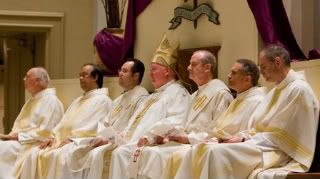 The Bishop at his chair is also a sign of the Church's unity because the Bishop is our connection to all the other dioceses around the world and to the first among Bishops, the Pope. The Pope is the Bishop of the Diocese of Rome, and he too has a cathedra in a church called the Cathedral Basilica of Saint John Lateran.
The Bishop at his chair is also a sign of the Church's unity because the Bishop is our connection to all the other dioceses around the world and to the first among Bishops, the Pope. The Pope is the Bishop of the Diocese of Rome, and he too has a cathedra in a church called the Cathedral Basilica of Saint John Lateran.When the Bishop is seated at the cathedra, especially when he is preaching, he is fully exercising his office, especially the role of teaching:
The Bishop as herald of the faith leads new followers to Christ. As their authentic teacher, that is, one invested with the authority of Christ, he proclaims to the people entrusted to him the truths of faith they are to believe and to live by. Under the light of the Holy Spirit the Bishop explains the teachings of faith, bringing forth from the treasurehouse of revelation new things and old. He works to make faith yield its harvest and, like the good shepherd, he is vigilant in protecting his people from the threat of error. (Ceremonial of Bishops, 15The Ceremonial (the Church's guidebook for any liturgical celebration with a Bishop) then states that "the office of preaching is proper to the Bishop, so that other ordained ministers fulfill this office only in his name," and "[u]nless he decides that some other way is preferable, the Bishop should preach while seated at the chair, wearing the miter and holding the pastoral staff" (17).
The Bishop, and through him all the priests and deacons of a diocese, are special signs of Christ. So when we look at the Bishop at his chair, we see Christ who is our Teacher, High Priest, and Good Shepherd.
Take a virtual pilgrimmage of the cathedrals in California at this very interesting and beautiful site.
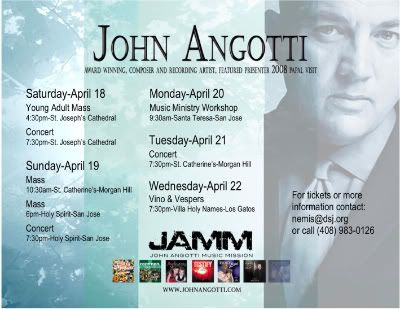
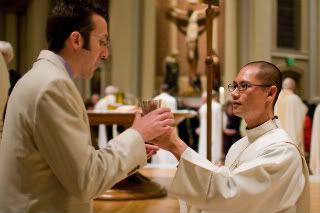 Bishop Patrick J. McGrath has asked all the parishes of the diocese of San Jose to offer the Communion cup to all the faithful at Mass, especially at Sunday and feast day Masses. By asking parishes to follow this policy, Bishop McGrath is highlighting the directive of the
Bishop Patrick J. McGrath has asked all the parishes of the diocese of San Jose to offer the Communion cup to all the faithful at Mass, especially at Sunday and feast day Masses. By asking parishes to follow this policy, Bishop McGrath is highlighting the directive of the